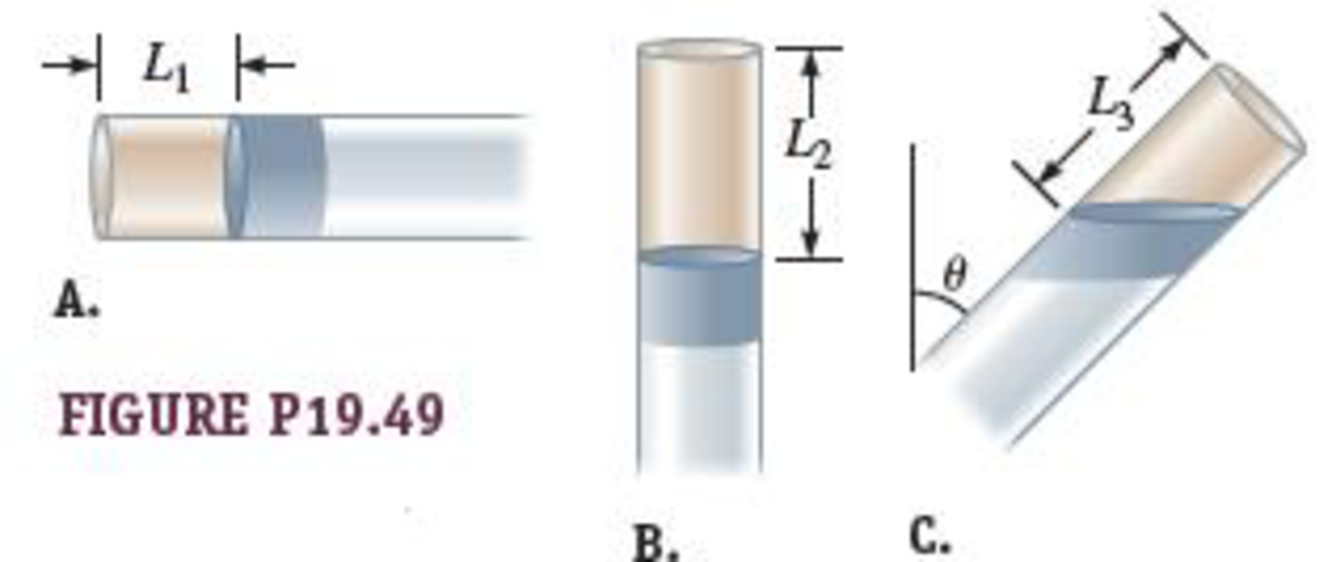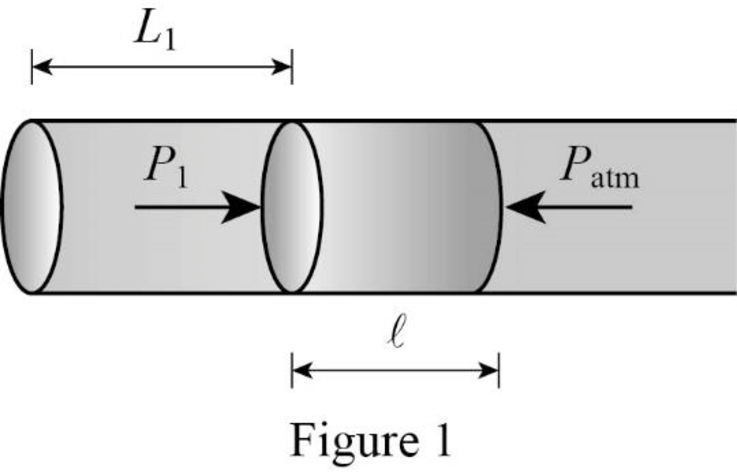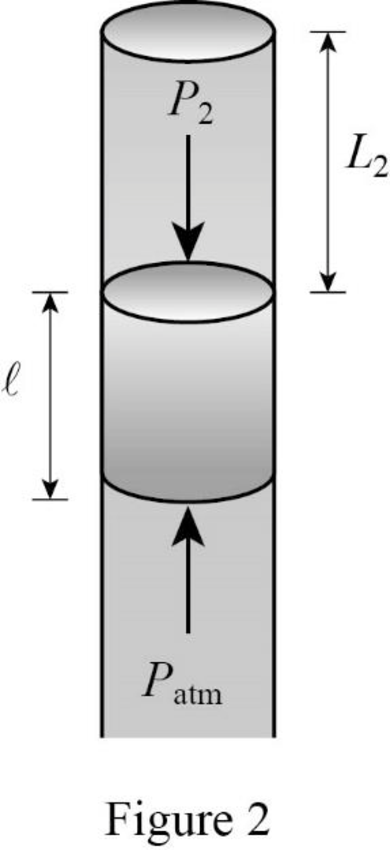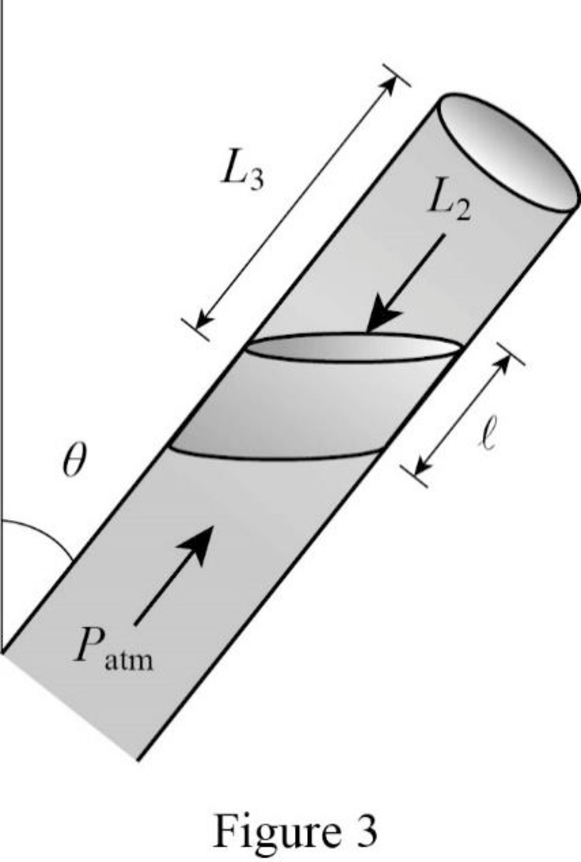
An ideal gas is trapped inside a tube of uniform cross-sectional area sealed at one end as shown in Figure P19.49. A column of mercury separates the gas from the outside. The tube can be turned in a vertical plane. In Figure P19.49A, the column of air in the tube has length L1, whereas in Figure P19.49B, the column of air has length L2. Find an expression (in terms of the parameters given) for the length L3 of the column of air in Figure P19.49C, when the tube is inclined at an angle θ with respect to the vertical.

FIGURE P19.49
The expression for the length
Answer to Problem 49PQ
The expression for the length
Explanation of Solution
Three cases are depicted here. The first case in which the length of the air column is
In all the three cases mercury separates the air from outside. In all the three cases mercury should be in static equilibrium. The forces experienced by the mercury are the force due to the pressure inside the tube, the force from the atmospheric pressure, and the force due to the weight of the mercury. Here the tube is maintained at constant pressure. So apply Boyle’s law.
Consider Figure 1.

Weight of mercury acts perpendicular to the orientation of the tube. Thus the mercury is in equilibrium whenever the atmospheric pressure is equal to the pressure inside the tube.
Here,
Consider Figure 2.

Here the outside atmospheric pressure is balanced by the sum of pressure in the tube due to the air column and the pressure due the weight of mercury.
Write the expression for the pressure due to the weight of mercury in position B.
Here,
Write the expression for the density of mercury.
Here,
Solve equation (III) for
Use expression (IV) in (II).
Here,
The atmospheric pressure at position B is balanced by the sum of pressures due to the weight of mercury, and pressure due to the column of air in the tube.
Here,
Consider the position 3.

Here the pressure due to atmosphere is balanced by pressure inside the tube due to gas column denoted by
Write the expression for the vertical component of pressure due to the weight of mercury column.
Here,
Write the expression for the balance of pressure in the tube kept in position 3.
Since the temperature is constant, apply Boyle’s law. Boyle’s law states that the volume of a gas is directly proportional to the pressure of the gas at constant temperature.
Write the expression for Boyle’s law for case A and case B.
Write the expression for volume of air in tube 1.
Here,
Write the expression for volume of air in tube 2.
Here,
Use expression (XI), (VII), (XII) and (I) in expression (X).
Solve expression for
Write the expression for Boyle’s law for case A and case C.
Write the expression for volume of air in tube 3.
Here,
Use expression (XI), (XVI), (IX) and (I) in expression (XV).
Solve expression (XVII) for
Equate the right hand sides of equations (XIV) and (XVIII) and solve for
Solve expression (XIX) for
Conclusion:
Therefore, the expression for the length
Want to see more full solutions like this?
Chapter 19 Solutions
EBK WEBASSIGN FOR KATZ'S PHYSICS FOR SC
- What is the meaning of a first order approximation?arrow_forwardNo chatgpt pls will upvote Already got wrong chatgptarrow_forwardA hydrogen atom has just a single electron orbiting the nucleus, which happens to be a single proton without any neutrons. The proton is positively charged, the electron negatively, but both with the same magnitude of charge given by e=1.602x10-19C. The mass of an electron is 9.11x10-31kg, and the proton is 1.67x10-27kg. Find the ratio of the electrostatic to the gravitational force of attraction between the electron and the proton in hydrogen. \arrow_forward
- What is the third law pair to the normal force as you sit in a chair? What effect does the sun's pull on earth have in terms of third law pairs?arrow_forwardUsing Newton's 2nd law, show that all objects subject to the pull of gravity alone should fall at the same rate. What is that rate?arrow_forwardNo chatgpt pls will upvotearrow_forward
- A cart on wheels (assume frictionless) with a mass of 20 kg is pulled rightward with a 50N force. What is its acceleration?arrow_forwardLight travels through a vacuum at a speed of 2.998 x 108m/s. Determine the speed of light in the following media: crown glass (n = 1.52)arrow_forward2.62 Collision. The engineer of a passenger train traveling at 25.0 m/s sights a freight train whose caboose is 200 m ahead on the same track (Fig. P2.62). The freight train is traveling at 15.0 m/s in the same direction as the passenger train. The engineer of the passenger train immediately applies the brakes, causing a constant acceleration of 0.100 m/s² in a direction opposite to the train's velocity, while the freight train continues with constant speed. Take x = 0 at the location of the front of the passenger train when the engineer applies the brakes. (a) Will the cows nearby witness a collision? (b) If so, where will it take place? (c) On a single graph, sketch the positions of the front of the pas- senger train and the back of the freight train.arrow_forward
- Can I get help with how to calculate total displacement? The answer is 78.3x-4.8yarrow_forward2.70 Egg Drop. You are on the Figure P2.70 roof of the physics building, 46.0 m above the ground (Fig. P2.70). Your physics professor, who is 1.80 m tall, is walking alongside the building at a constant speed of 1.20 m/s. If you wish to drop an egg on your profes- sor's head, where should the profes- sor be when you release the egg? Assume that the egg is in free fall. 2.71 CALC The acceleration of a particle is given by ax(t) = -2.00 m/s² +(3.00 m/s³)t. (a) Find the initial velocity Vox such that v = 1.20 m/s 1.80 m 46.0 marrow_forwardOne has to push down a ball with a force of 470 Newtons in order to hold the ball still, completely submerged under the surface of the water. What is the volume of the styrofoam ball in cubic meters? Use 997 kg/m3 as the density of water, 95 kg/m3 for the density of the styrofoam, and g = 9.8 m/s2.arrow_forward
 Physics for Scientists and Engineers: Foundations...PhysicsISBN:9781133939146Author:Katz, Debora M.Publisher:Cengage Learning
Physics for Scientists and Engineers: Foundations...PhysicsISBN:9781133939146Author:Katz, Debora M.Publisher:Cengage Learning Physics for Scientists and EngineersPhysicsISBN:9781337553278Author:Raymond A. Serway, John W. JewettPublisher:Cengage Learning
Physics for Scientists and EngineersPhysicsISBN:9781337553278Author:Raymond A. Serway, John W. JewettPublisher:Cengage Learning Physics for Scientists and Engineers with Modern ...PhysicsISBN:9781337553292Author:Raymond A. Serway, John W. JewettPublisher:Cengage Learning
Physics for Scientists and Engineers with Modern ...PhysicsISBN:9781337553292Author:Raymond A. Serway, John W. JewettPublisher:Cengage Learning College PhysicsPhysicsISBN:9781305952300Author:Raymond A. Serway, Chris VuillePublisher:Cengage Learning
College PhysicsPhysicsISBN:9781305952300Author:Raymond A. Serway, Chris VuillePublisher:Cengage Learning Principles of Physics: A Calculus-Based TextPhysicsISBN:9781133104261Author:Raymond A. Serway, John W. JewettPublisher:Cengage Learning
Principles of Physics: A Calculus-Based TextPhysicsISBN:9781133104261Author:Raymond A. Serway, John W. JewettPublisher:Cengage Learning College PhysicsPhysicsISBN:9781285737027Author:Raymond A. Serway, Chris VuillePublisher:Cengage Learning
College PhysicsPhysicsISBN:9781285737027Author:Raymond A. Serway, Chris VuillePublisher:Cengage Learning





